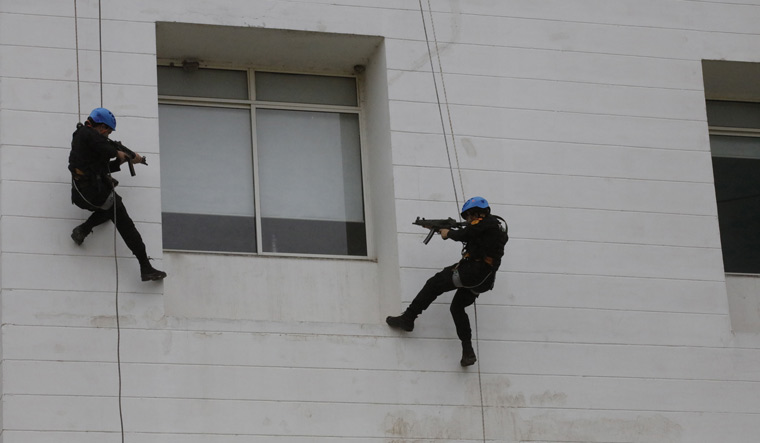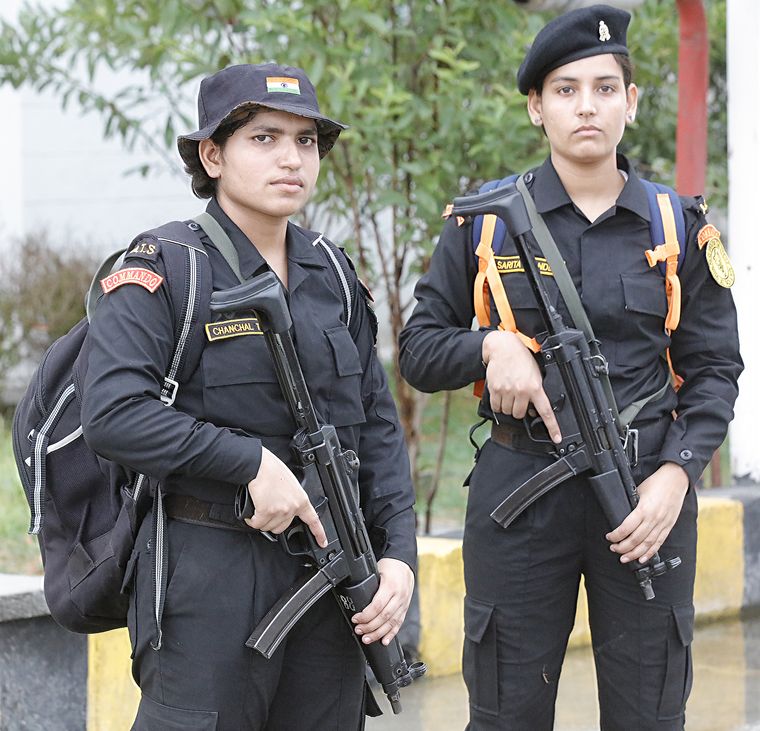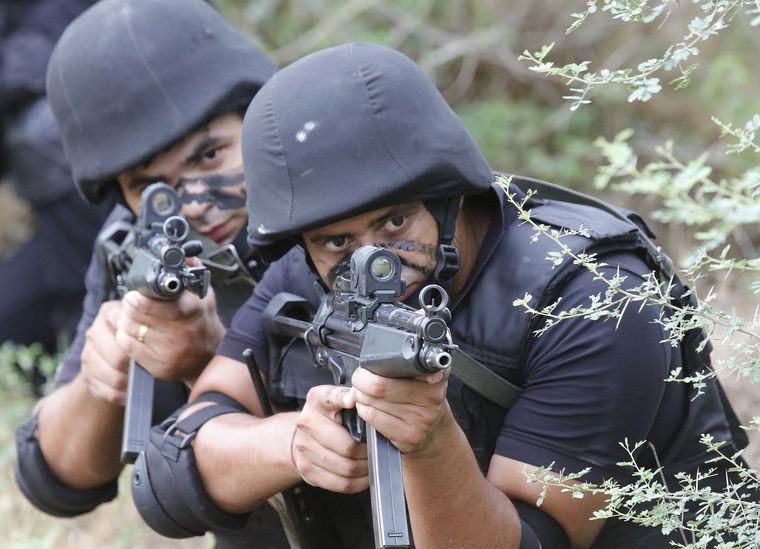It was raining bullets. Chanchal Teotia rappelled down a multi-storey building, pulled out an MP5 submachine gun and shot down hostiles. She then smashed a window and entered the building to rescue hostages and neutralise the remaining hostiles. The building was secured in no time. Chanchal removed her headgear. The mock drill was complete.
Her instructors know Chanchal as a quiet girl with limited vocabulary and unlimited courage. The 23-year-old hails from the outlying town of Bulandshahr, which sits on top of the crime charts in Uttar Pradesh. She is the youngest female commando of the state’s anti-terrorist squad (ATS) and the latest entrant to the elite all-women strike team being assembled by Chief Minister Yogi Adityanath.
The team is part of Adityanath’s new security blueprint, which he unveiled after returning to power in March. It includes women police battalions across the state and the creation of women commando units, among other initiatives. Prashant Kumar, additional director general of police (law and order), Uttar Pradesh, said: “If women are present in a terror group, or there is a hostage situation in a house or public spaces like malls or cinema halls, where hostages taken are mostly women, our women commandos will be most effective in counter-terror action and negotiation.”
It was former Tamil Nadu chief minister J. Jayalalithaa who formed India’s first female commando unit, in the 1990s. Assam, Nagaland, West Bengal, Kerala, Uttarakhand and Bihar followed suit. Kumar told THE WEEK that the Uttar Pradesh ATS’s women commandos were being trained to handle a range of equipment and weapons. “A good start was made when they completed training in Krav Maga,” he said. “They are now undergoing training with the National Security Guard, the Border Security Force, and the Indo-Tibetan Border Police.” Volunteers can apply for the ATS after six years in the police or provincial armed constabulary; age limit is 40 for constables and 45 for inspectors.
Chanchal’s journey is just the beginning. “Coming from a humble background where neighbours never allow us to forget that we are women, I first try to prove myself and then prove my [aptitude for the] job,” she said. Trying to do both, they end up doing better than men, she added with a smile.
Her friend and mentor, Priyanka Panwar, 31, is the first ATS woman commando. She joined the police force in 2011 and was selected to join the ATS in 2017. Born in Ghatayan village in communally sensitive Muzaffarnagar, Priyanka belongs to a farming family. But, she realised early in life that sports, like wrestling, was her calling. “I was a wrestler in university and represented the police team,” she said. “I wanted to do a tough job. When I got into the ATS, I was the only woman around. Sometimes, it was awkward when I did not see a single woman for days. But, when there are no barriers of gender or strength, you emerge victorious.”
Nitika Sharma, 32, wanted to join the armed forces after her graduation from Khalsa College in Delhi. She is from Ghaziabad. Her mother is a government health worker and her father works in the private sector. “There are limited avenues for women who want to serve the country,” said Nikita. “In 2016, I joined the police, but I wanted to serve the country in a bigger way. Now, I know how to use firearms and I am training with the best of forces like the BSF and the NSG. The commando training has made me mentally and physically stronger.”
Umang Tomar, 31, from the small town of Bagpat recalled her recent visit to DefExpo 2022, where she was treated like a hero by children who gathered around her seeing her black uniform. “There are moments during training when we feel tired and motivation goes down,” she said. “But, the respect we get as commandos is unparalleled and we regain strength.” Her father, a retired head constable from the state police, had told her that if she wanted to live a life of adventure, she could join the police.
Anisha Mavi, 32, was training to become a Hindi teacher and wrote poetry till she joined the ATS in 2018. Today, she is proficient in lobbing grenades, riding bikes and firing guns. “Now, I don’t get time [for poetry],” she said, with a laugh. “I spend all my time rappelling or slithering.”
None of the girls are married. “Settling down in one place is a problem,” said Anisha. “Moreover, a civilian man will get scared of my black uniform.” Umang felt it requires men of steel to marry the elite women commandos. “Let us hope we find them,” she said.
Recent terror attacks in Rajasthan and Punjab and at the Gorakhnath temple (averted by the ATS) have once again put focus on the hotbeds of terror in the hinterland. The next postings for the women commandos will be in these pockets. Sleeper cells in the hotbeds have traditionally provided a feeder line to outfits like Al Qaeda in the Indian Subcontinent and other groups backed by the Students’ Islamic Movement of India.
The women commandos will also be deployed at ATS centres coming up at Aligarh, Agra, Azamgarh, Bareilly, Bahraich, Gorakhpur, Moradabad, Meerut, Varanasi, Shravasti, Saharanpur and Kanpur. The expansion of the ATS is a key part of Adityanath’s new security blueprint. Apart from the new centres, the ATS is also setting up new commando hubs (larger contingents) at Ayodhya, Rampur and Varanasi, along with special task force units to secure vital installations. These measures are in line with the vision to make Uttar Pradesh the biggest international Hindu religious circuit, and a major industrial hub, in years to come.
D.S. Chauhan, director general of police, Uttar Pradesh, said: “In the coming years, the surveillance team will be exposed to new fields and threats like anti-drone attacks system, drone forensics, financial forensics and darknet patrolling,” he said. “On the other hand, the commandos will be imparted the best of training in field-craft and tactics available in the country and abroad.”
Senior intelligence officials in the state said that the creation of local commando units of the ATS is beneficial since these commandos understand the complex social milieu. Counterterrorism efforts so far have lagged in the country because forces are deployed from outside a state and do not understand the language, thought or terrain. “Whether it is Jammu or Kashmir, Andhra Pradesh or Uttar Pradesh, the local commandos will always have a better grip of the ground situation and naturally develop intelligence networks that will help during a counterterrorist operation,” said K. Srinivasan, former inspector general, BSF, and former IG, Central Reserve Police Force, who set up intelligence wings in both the forces.
The challenges are multifold in Uttar Pradesh where sustainable employment opportunities are still missing for a large segment of the population. Terror operatives and sympathisers are constantly scouting for vulnerable minds. The ATS is forming guidelines to launch a de-radicalisation programme and is roping in psychiatrists to help wean the youth away from extremist ideologies and violence. But, the ATS is also facing newer challenges.
The latest intelligence reports point towards threats from illegal migrants, like the Rohingyas. The ATS is working on leads to detect the modules that are sponsoring their entry into the state and helping them procure fake identity cards and settle as labourers or students. Estimates with agencies point towards the presence of at least 500 people who have entered the state and the ATS is making a data bank to track each person. “Some are arrested if they are indulging in anti-national activities, while others need to be deported,” said an official, who requested anonymity. “The entire family has to be deported, so it is a big task to identify all the men, women and children in one family.”
Meanwhile, there is silence in towns like Azamgarh, which came under the spotlight after successive terror bombings followed by the 2008 Batla House encounter. Indian Mujahideen operatives like Atif Ameen and Mohammed Sajid were killed in the encounter. While there were arrests like that of Mohammed Saif and Zeeshan Ahmad, others like Dr Shahnawaz and Mohammed Sajid fled the country. ATS chief Naveen Arora said a close watch is being kept on all the terror hotbeds. “The families of the absconding terrorists do not talk about them,” he said.
For the newly formed ATS units and its commandos, the challenge will be to ensure that the silence is maintained.




